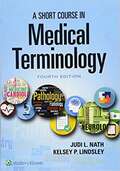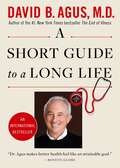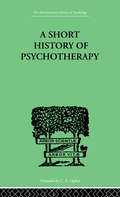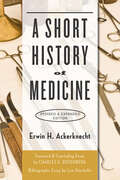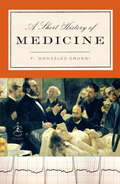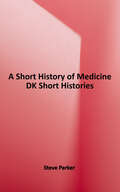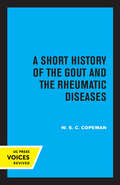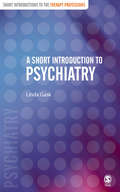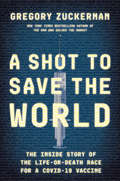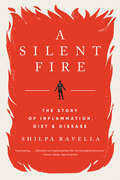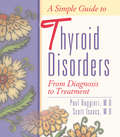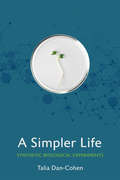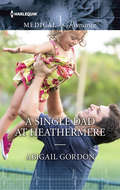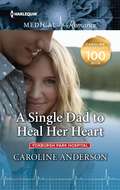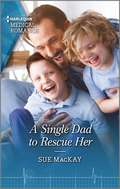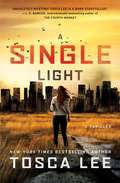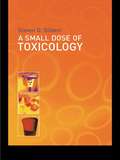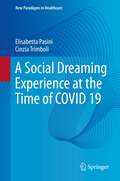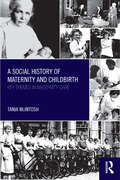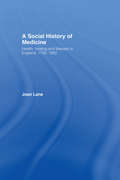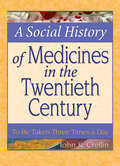- Table View
- List View
A Short Course in Medical Terminology
by Judi L. NathRetaining its logical organization, body systems approach, and focus on word parts, word building, and word analysis; this Fourth Edition of A Short Course in Medical Terminology reflects current medical usage and is now even more concise, student-friendly, and accessible. <p><p> This edition features an enhanced art and design program, a more standardized chapter structure, and a vast array of in-text and online learning resources that help students master the language of medicine as they prepare for practice in today’s rapidly changing healthcare environment.
A Short Guide to Clinical Pharmacokinetics
by Krishnaveni Manubolu Raveesha Peeriga K. B. ChandrasekharThis book is a complete resource on pharmacokinetics, pharmacodynamics and pharmacogenomics in clinical practice. It consists of seven chapters that cover various aspects of pharmacokinetics and its clinical applications. The chapters are structured to provide clear objectives and keywords are bolded throughout the text to facilitate understanding. The topics covered include the significance of pharmacokinetics in clinical practice, factors affecting pharmacokinetic parameters, pharmacokinetic drug interactions, therapeutic drug monitoring, dosage adjustment in different population groups, the influence of hepatic diseases on pharmacokinetics and the impact of pharmacogenomics on pharmacokinetics and pharmacodynamics. The book is written in simple language to make the concepts accessible to all readers. This book is a comprehensive resource for students pursuing a doctoral degree in pharmacy, as well as academicians and researchers in clinical pharmacokinetics.
A Short Guide to a Long Life
by David B. AgusThe New York Times bestselling book of simple rules everyone should follow in order to live a long, healthy life, featuring illustrations throughout, from the author of The End of Illness.In his international bestseller, The End of Illness, Dr. David B. Agus shared what he has learned from his work as a pioneering cancer doctor, revealing the innovative steps he takes to prolong the lives of not only cancer patients, but all those who want to enjoy a vigorous, lengthy life. Now Dr. Agus has turned his research into a practical and concise illustrated handbook for everyday living. A Short Guide to a Long Life is divided into three sections (What to Do, What to Avoid, and Doctor's Orders) that provide the definitive answers to many common and not-so-common questions: Who should take a baby aspirin daily? Are flu shots safe? What constitutes "healthy" foods? Are airport scanners hazardous? Dr. Agus believes optimal health begins with our daily routines. His book will help you develop new patterns of personal health care, using inexpensive and widely available tools that are based on the latest and most reliable science. An accessible and essential handbook for preparing for visits to the doctor and maintaining control of your future, "A Short Guide to a Long Life explores the simple idea that a healthy tomorrow starts with good habits today" (Fortune).
A Short History Of Psychotherapy: In Theory and Practice (International Library Of Psychology)
by Walker, NigelFirst published in 1999. Routledge is an imprint of Taylor & Francis, an informa company.
A Short History of Medicine
by Erwin H. AckerknechtA bestselling history of medicine, enriched with a new foreword, concluding essay, and bibliographic essay.Erwin H. Ackerknecht’s A Short History of Medicine is a concise narrative, long appreciated by students in the history of medicine, medical students, historians, and medical professionals as well as all those seeking to understand the history of medicine.Covering the broad sweep of discoveries from parasitic worms to bacilli and x-rays, and highlighting physicians and scientists from Hippocrates and Galen to Pasteur, Koch, and Roentgen, Ackerknecht narrates Western and Eastern civilization’s work at identifying and curing disease. He follows these discoveries from the library to the bedside, hospital, and laboratory, illuminating how basic biological sciences interacted with clinical practice over time. But his story is more than one of laudable scientific and therapeutic achievement. Ackerknecht also points toward the social, ecological, economic, and political conditions that shape the incidence of disease. Improvements in health, Ackerknecht argues, depend on more than laboratory knowledge: they also require that we improve the lives of ordinary men and women by altering social conditions such as poverty and hunger.This revised and expanded edition includes a new foreword and concluding biographical essay by Charles E. Rosenberg, Ackerknecht’s former student and a distinguished historian of medicine. A new bibliographic essay by Lisa Haushofer explores recent scholarship in the history of medicine.
A Short History of Medicine
by Frank Gonzalez-CrussiIn this lively, learned, and wholly engrossing volume, F. González-Crussi presents a brief yet authoritative five-hundred-year history of the science, the philosophy, and the controversies of modern medicine. While this illuminating work mainly explores Western medicine over the past five centuries, González-Crussi also describes how modern medicine's roots extend to both Greco-Roman antiquity and Eastern medical traditions. Covered here in engaging detail are the birth of anatomy and the practice of dissections; the transformation of surgery from a gruesome art to a sophisticated medical specialty; a short history of infectious diseases; the evolution of the diagnostic process; advances in obstetrics and anesthesia; and modern psychiatric therapies and the challenges facing organized medicine today. González-Crussi's approach to these and other topics stems from his professed belief that the history of medicine isn't just a continuum of scientific achievement but is deeply influenced by the personalities of the men and women who made or implemented these breakthroughs. And, as we learn, this field's greatest practitioners were, like the rest of us, human beings with flaws, weaknesses, and limitations-including some who were scoundrels.Insightful, informed, and at times controversial in its conclusions, A Short History of Medicine offers an exceptional introduction to the major and many minor facets of its subject. Written by a renowned author and educator, this book gives us the very essence of humankind's search to mitigate suffering, save lives, and unearth the mysteries of the human animal. Praise for F. González-Crussi"What Oliver Sacks does for the mind, González-Crussi [does] for the eye in this captivating set of philosophical meditations on the relationship between the viewer and the viewed."-Publishers Weekly, on On Seeing"[González-Crussi fuses] science, literature, and personal history into highly civilized artifacts."-The Washington Post, on There Is a World ElsewhereFrom the Hardcover edition.
A Short History of Medicine (Dk Short Histories Ser.)
by Steve ParkerImmerse yourself in the history of medicine – a colorful story of skill, serendipity, trial and error, moments of genius, and dogged determination. From traditional Chinese medicine to today’s sophisticated gene therapies and robotic surgery, A Short History of Medicine combines riveting storytelling and beautiful images, historical accounts, and lucid explanations, to illuminate the story of medicine through time. Witness early, bloody, anesthetic-free operations; see the first crude surgical instruments; trace the mapping of the circulatory system; follow the painstaking detective work that led to the decoding of the human genome; and understand the role that potions, cures, therapies, herbal medicines, and drugs have played in the human quest to tame and conquer disease, injury, and death. Dive deep into this magnificent medicine book to discover: - Vivid, compelling, and informative reads written in an engaging and colorful style - Excerpts from documents, diaries, and notebooks offer fascinating eyewitness accounts. - Charts and contextualizes the great milestones of medical history. A Short History of Medicine is a fascinating illustrated history and tale of drama and discovery that celebrates the milestones of medical history across generations and cultures. From eradicating smallpox to the early anesthetics, the very first transplants to the genetic code, this groundbreaking guide to the history of medicine has something for everyone to explore, learn, and discover. Ideal for adults and young adults alike, whether you have a keen interest in medicine, science or social history, this all-encompassing medicine book is sure to quench your thirst for knowledge!
A Short History of the Gout and the Rheumatic Diseases
by W.S.C. CopemanThis title is part of UC Press's Voices Revived program, which commemorates University of California Press’s mission to seek out and cultivate the brightest minds and give them voice, reach, and impact. Drawing on a backlist dating to 1893, Voices Revived makes high-quality, peer-reviewed scholarship accessible once again using print-on-demand technology. This title was originally published in 1964.
A Short Introduction to Psychiatry (Short Introductions to the Therapy Professions)
by Dr Linda GaskA Short Introduction to Psychiatry is designed to give readers a clear picture of the profession of psychiatry as it is today as well as an understanding of the subject from which to develop further study. The author describes the development of the profession, the route to qualification and the scope of contemporary practice, including the work done by psychiatrists in a range of specialisms - from child psychiatry to addiction services and forensic psychiatry. Drawing on the experience of people who have been through psychiatric treatment, the book also explores what psychiatry is like from the patient's/user's perspective. Many criticisms have been levelled against the profession and the author, Linda Gask, summarizes key debates which have been and continue to be played out between psychiatry's critics and its defenders. A Short Introduction to Psychiatry is for anyone looking into psychiatry for the first time, whether with a view to training or out of more general interest.
A Short-Cut to Understanding Affective Neuroscience
by Lucy Biven"A Short-Cut to Understanding Affective Neuroscience is a remarkable book that will appeal to academics and laymen, theoreticians and clinicians. Readers will appreciate Lucy Biven's thorough research and her straightforward language. She does not avoid complexity and uncertainty when addressing challenging questions in neuroscience." <p>~Donald Campbell: Past President and Distinguished Fellow of the British Psychoanalytical Society <p><p> This book clarifies and evaluates vast amounts of neuroscientific research, arriving at a clear and concise framework that demonstrates how to ground mental health practice in the results of neuroscience. <p><p> With a seamless narrative that weaves and explains complex theories, experimental research, and clinical practice, this book will interest mental health professionals and anyone who wants to learn more about the affective life of people and other mammals. <p><p> Beginning with a survey of the theories of affective consciousness, this book first shows that, for all mammals, affects are unique experiences of pleasure and pain, emanating from deep noncognitive brain structures. These subcortical structures in and around the brain stem generate seven basic types of affective consciousness, the existence and breadth of which have important implications for the practice of psychotherapy and psychiatry. For example, the two distinct types of anxiety, each originating in a different system, explain the effectiveness of different medications. <p><p> Understanding affects also provides the theoretical basis for conditioning where disparate ideas, as affect-laden memories, can become associated. Thus, by understanding a client's affects, a psychotherapist can make sense of seemingly disconnected ideas that arise in the therapeutic conversation.
A Shot to Save the World: The Inside Story of the Life-or-Death Race for a COVID-19 Vaccine
by Gregory Zuckerman"An inspiring and informative page-turner." –Walter IsaacsonLonglisted for the FT/McKinsey Business Book of the Year Award The authoritative account of the race to produce the vaccines that are saving us all, from the #1 New York Times bestselling author of The Man Who Solved the MarketFew were ready when a mysterious respiratory illness emerged in Wuhan, China in January 2020. Politicians, government officials, business leaders, and public-health professionals were unprepared for the most devastating pandemic in a century. Many of the world&’s biggest drug and vaccine makers were slow to react or couldn&’t muster an effective response. It was up to a small group of unlikely and untested scientists and executives to save civilization. A French businessman dismissed by many as a fabulist. A Turkish immigrant with little virus experience. A quirky Midwesterner obsessed with insect cells. A Boston scientist employing questionable techniques. A British scientist despised by his peers. Far from the limelight, each had spent years developing innovative vaccine approaches. Their work was met with skepticism and scorn. By 2020, these individuals had little proof of progress. Yet they and their colleagues wanted to be the ones to stop the virus holding the world hostage. They scrambled to turn their life&’s work into life-saving vaccines in a matter of months, each gunning to make the big breakthrough—and to beat each other for the glory that a vaccine guaranteed. A #1 New York Times bestselling author and award-winning Wall Street Journal investigative journalist lauded for his &“bravura storytelling&” (Gary Shteyngart) and &“first-rate&” reporting (The New York Times), Zuckerman takes us inside the top-secret laboratories, corporate clashes, and high-stakes government negotiations that led to effective shots. Deeply reported and endlessly gripping, this is a dazzling, blow-by-blow chronicle of the most consequential scientific breakthrough of our time. It&’s a story of courage, genius, and heroism. It&’s also a tale of heated rivalries, unbridled ambitions, crippling insecurities, and unexpected drama. A Shot to Save the World is the story of how science saved the world.
A Silent Fire: The Story Of Inflammation, Diet, And Disease
by Shilpa Ravella“Fascinating.…[Ravella’s writing] breathes life into biological functions.” —Grace Wade, New Scientist A riveting investigation of inflammation—the hidden force at the heart of modern disease—and how we can prevent, treat, or even reverse it. Inflammation is the body’s ancestral response to its greatest threats, the first line of defense it deploys against injury and foreign pathogens. But as the threats we face have evolved, new science is uncovering how inflammation may also turn against us, simmering underneath the surface of leading killers from heart disease and cancer to depression, aging, and mysterious autoimmune conditions. In A Silent Fire, gastroenterologist Shilpa Ravella investigates hidden inflammation’s emerging role as a common root of modern disease—and how we can control it. We meet the visionary nineteenth-century pathologist who laid the foundation for our modern understanding of inflammation, the eccentric Russian zoologist who discovered one of the cells central to our immune system, and the dedicated researchers advancing the frontiers of medical and nutritional science today. With fascinating case studies, Ravella reveals how we can reform our relationships with food and our microbiomes to benefit our own health and the planet’s. Synthesizing medical history, cutting-edge research, and innovative clinical practice, Ravella unveils inflammation as one potential basis for a unifying theory of disease. A paradigm-shifting understanding of one of the most mysterious, buzzed-about topics in medicine and nutrition, A Silent Fire shows us how to live not only long but well.
A Simple Guide to Thyroid Disorders: From Diagnosis to Treatment
by Scott Isaacs Paul Ruggieri Jack Allen KuslerDo You Have a Thyroid Disorder? If your doctor has told you that you have a thyroid disorder, perhaps you feel some relief in having pinpointed the source of your troublesome symptoms. As you may know, thyroid ailments often elude a diagnosis since they may mimic other illnesses. Now that you have a diagnosis, becoming informed will help you receive better health care. The authors, specialists in thyroid treatment, can help you understand both the complex function of your thyroid and how your disorder can best be treated. In A Simple Guide to Thyroid Disorders, they take special care to lay out the basics in a reader-friendly way. Among the topics they discuss: · medical tests you need to diagnose thyroid problems · hypothyroidism...symptoms and treatment · hyperthyroidism...symptoms and treatment · coping with emotional highs and lows · dealing with thyroid-related weight problems · medications and surgeries for thyroid disorders · thyroid nodules and cancers A Simple Guide to a Complex Disorder
A Simpler Life: Synthetic Biological Experiments (Expertise: Cultures and Technologies of Knowledge)
by Talia Dan-CohenA Simpler Life approaches the developing field of synthetic biology by focusing on the experimental and institutional lives of practitioners in two labs at Princeton University. It highlights the distance between hyped technoscience and the more plodding and entrenched aspects of academic research. Talia Dan-Cohen follows practitioners as they wrestle with experiments, attempt to publish research findings, and navigate the ins and outs of academic careers. Dan-Cohen foregrounds the practices and rationalities of these pursuits that give both researchers' lives and synthetic life their distinctive contemporary forms. Rather than draw attention to avowed methodology, A Simpler Life investigates some of the more subtle and tectonic practices that bring knowledge, doubt, and technological intervention into new configurations. In so doing, the book sheds light on the more general conditions of contemporary academic technoscience.
A Single Dad at Heathermere
by Abigail GordonA wedding in the springtimeThe pretty village of Heathermere is not only a home but also a sanctuary for Jon Emmerson and his young daughter, Abby. Here, he's been able to focus on being a father and on his jobas the local doctor, leaving his past behind. Unexpectedly bumping into his childhood friend Dr. Laura Cavendish may change all that.Jon is captivated by Laura, also a struggling single parent, and he soon realizes they are meant to be a family. When he proposes, Laura is tempted, but, believing he's offering a marriage of convenience, she refuses. Jon knows he must convince Laura of his love before there can be another wedding at Heathermere.
A Single Dad to Heal Her Heart: A Single Dad To Heal Her Heart (yoxburgh Park Hospital) / Resisting Her Rescue Doc (rescue Docs) (Yoxburgh Park Hospital)
by Caroline AndersonCould a single dad of two……be the answer to her dreams?Trauma doc Livvy Henderson loves her job and friends, and she’s been cancer free for five years. She’s content…until she meets widowed father, handsome surgeon Matt Hunter on a team weekend in Cumbria. Their powerful connection reawakens her fears, desires and longing for a family she’s long since locked away. But Matt finds he’s ready to convince her she belongs in his, whatever the future holds…“Bound by Their Babies is a sweet inspirational story of friendship and second chances. A book that will yank at any reader’s heartstrings.”— Goodreads“Ms. Anderson has delivered a wonderful read in this book where the chemistry between this couple was strong and present from the moment they met; the romance was heart-warming and had me loving these two together; and the ending had me crying happy tears because things happen for a reason.”— Harlequin Junkie on Their Own Little Miracle
A Single Dad to Rescue Her (Queenstown Search & Rescue #2)
by Sue MacKayA tempting paramedic…His second chance at love?Called out to an avalanche, firefighting chief Jamie comes to strong-willed Kayla&’s rescue. He&’ll never forget the way Kayla gripped his hand. Or how the gutsy paramedic instructed him on how to save her! But he&’s vowed not to pursue a relationship until his boys are grown. None of them can suffer another heartbreak. Yet Jamie feels an unrelenting pull toward Kayla. Might it be her turn next to save him?A Queenstown Search & Rescue novel Queenstown Search & Rescue trilogyBook 1 – Captivated by Her Runaway DocBook 2 – A Single Dad to Rescue HerBook 3 – From Best Friends to I Do? &“…the plot was interesting, and their romantic scenes were sweet but still hot, hot, hot…you&’ll be hooked.&”-Harlequin Junkie on A Fling to Steal Her Heart &“Overall, Ms. MacKay has delivered a really good read in this book where the chemistry between this couple was strong; the romance was delightful and had me loving how these two come together….&”-Harlequin Junkie on The Italian Surgeon&’s Secret Baby
A Single Light: A Thriller (The Line Between #2)
by Tosca LeeIn this gripping, high-octane sequel to The Line Between, which New York Times bestselling author Alex Kava calls &“everything you want in a thriller,&” cult escapee Wynter Roth and ex-soldier Chase Miller emerge from their bunker to find a country ravaged by disease.Six months after vanishing into an underground silo with sixty-one others, Wynter and Chase emerge to an altered world. There is no sign of Noah and the rest of the group that was supposed to greet them when they surfaced—the same people Wynter was counting on to help her locate the antibiotics her gravely ill friend, Julie, needs. As the clock ticks down on Julie&’s life, Wynter and Chase embark on a desperate search for medicine and answers. But what they find is not a nation on the cusp of recovery but one decimated by disease. What happened while they were underground? With food and water in limited supply and their own survival in question, Chase and Wynter must venture further and further from the silo. They come face-to-face with a radically changed society, where communities scrabble to survive under rogue leaders and cities are war zones. As hope fades by the hour and Wynter learns the terrible truth of the last six months, she is called upon again to help save a nation she no longer recognizes—a place so chaotic she&’s no longer sure it can even survive. With Tosca Lee&’s signature &“beautifully written and deeply unnerving&” (Jonathan Maberry, New York Times bestselling author) prose, A Single Light is a breathless thriller of nonstop suspense.
A Singular View: The Art of Seeing With One Eye
by Frank B. BradyExcellent resource for those with monocular vision. This is perhaps the single best source of information for those who have lost sight in one eye, as well as for anyone who must lend support to, or who simply wants to better understand the unique challenges and opportunities of, those facing life with a "singular view."
A Sister's Dilemma: An Uplifting Medical Romance (The Wilde Twins #1)
by Gill SandersonThe first novel in Gill Sanderson's delightful The Wilde Twins series, perfect for fans of Mia Faye, Laura Scott, Helen Scott Taylor, Grey's Anatomy and ER.Readers LOVE Gill's charming medical romances!'Wonderful writer! Wonderful story! Wonderful book!' 5* reader review'Loved this book really good story. Excellent story line very good author' 5* reader review'I loved this book very hard to put down. Just what you need for a relaxing evening' 5* reader review After years spent wandering, Nurse Kate Wilde returns home for a few short days to attend her twin sister's wedding. But after suffering an accident, Kate, is forced to stay longer. There's a tempting distraction in the form of Dr Steve Russell, a handsome and troubled doctor who once loved Kate's sister, but who wants nothing to do with a long-term commitment...Don't miss Gill Sanderson's enthralling medical romances, including the A Lakeland Practice and the Good, Bad and Ugly series.
A Small Dose of Toxicology: The Health Effects of Common Chemicals
by Steven G. GilbertEveryday, we come into contact with many relatively harmless substances that could, at certain concentrations, be toxic. This applies not only to obvious candidates such as asbestos, lead, and gasoline, but also to compounds such as caffeine and headache tablets. While the field of toxicology has numerous texts devoted to aspects of biology, chemis
A Social Dreaming Experience at the Time of COVID 19 (New Paradigms in Healthcare)
by Elisabetta Pasini Cinzia TrimboliThe book describes the experience of four Social Dreaming Matrices held online between March and May 2020, during the first lockdown caused by the Covid 19 emergency. The pandemic isolated us and imposed prolonged contact with ourselves and our solitary thoughts. Against this backdrop, there was hope for change, a desire for a different kind of sociability and different forms of intimacy. On the basis of this evidence, our research supports the shift "from experiencing trauma to reacting to trauma", looking at a collective traumatic experience not only as something to be overcome but as an opportunity for a transformation that changes our mental schemes in relation to the external context. We have identified Social Dreaming as a privileged technique to overcome a collective traumatic experience, supporting its elaboration through collective feelings, new connections between intuition and rational thought, the discovery of community meanings. The authors's thesis is that the much-needed transition from 'magical thinking' to 'transformative thinking' takes place in a setting that is able to contain the anxieties of life's transitional phases, supporting the creation of new rituals and new social bonds and sustaining the passage from “me” to a “wider we”.
A Social History of Maternity and Childbirth: Key Themes in Maternity Care
by Tania McIntoshPeople are fascinated by stories of childbirth, and the sources to document maternity in Britain in the twentieth century are rich and varied. This book puts the history of maternity in England into its wider social context, highlighting areas of change and continuity, and charting the development of pregnancy and birth as it emerged from the shadows and became central to social debate. A Social History of Maternity and Childbirth considers the significance of the regulation and training of midwives and doctors, exploring important aspects of maternity care including efforts to tackle maternal deaths, the move of birth from home to hospital, and the rise of consumer groups. Using oral histories and women’s memoirs, as well as local health records and contemporary reports and papers, this book explores the experiences of women and families, and includes the voices of women, midwives and doctors. Key themes are discussed throughout, including: the work and status of the midwife the place of birth pain relief ante- and post- natal care women’s pressure groups high-tech versus low-tech political pressures. At a time when the midwifery profession, and the wider structure of maternity care, is a matter for popular and political debate, this book is a timely contribution. It will be an invaluable read for all those interested in maternity care in England.
A Social History of Medicine: Health, Healing and Disease in England, 1750-1950
by Joan LaneA Social History of Medicine traces the development of medical practice from the Industrial Revolution right through to the twentieth century. Drawing on a wide range of source material, it charts the changing relationship between patients and practitioners over this period, exploring the impact made by institutional care, government intervention and scientific discovery. The study illuminates the extent to which medical assistance really was available to patients over the period, by focusing on provincial areas and using local sources. It introduces a variety of contemporary medical practitioners, some of them hitherto unknown and with fascinating intricate details of their work. The text offers an extensive thematic survey, including coverage of: * institutions such as hospitals, dispensaries, asylums and prisons* midwifery and nursing* infections and how changes in science have affected disease control* contraception, war, and the NHS.
A Social History of Medicines in the Twentieth Century: To Be Taken Three Times a Day
by John Crellin Dennis B WorthenGet a fresh perspective on the day-to-day use of medicine! A Social History of Medicines in the Twentieth Century explores the most perplexing issues concerning the uses of prescriptions and other medicines on both sides of the Atlantic. The book equips you with a thorough understanding of the everyday use of medicine in the United States, Canada, and Britain, concentrating on its recent past. Dr. John K. Crellin, author of several influential books on the history of medicine and pharmacy, addresses vital topics such as: the emergence of prescription-only medicines; gate-keeping roles for pharmacists; the role of the drugstore; and the rise of alternative medicines. A Social History of Medicines in the Twentieth Century adds the historical perspective missing from most medical and pharmaceutical literature about trends in the day-to-day use of medicines in society. The book is essential reading for anyone taking regular medication, either as self-care or by a physician&’s prescription. Topics discussed include the non-scientific factors that validate medicines, the relevance of the control of narcotics, marketing strategies used by the pharmaceutical industry, the changing authority of physicians and pharmacists, over-the-counter medicines, tonics and sedatives, and patient compliance-and non-compliance. A Social History of Medicines in the Twentieth Century also addresses: medicines for weakness ("health" foods, fortifiers, digestives/laxatives) poison and pharmacy legislation placebos tranquilizers and antidepressants hormones side-effects psychoactive medications herbal medicines a brief history of the use of medicines from the 17th to 19th centuries suggestions for future policies and much more! A Social History of Medicines in the Twentieth Century is equally vital as a professional resource for physicians, pharmacists, and health care administrators, as a classroom guide for academics working in the medical and pharmaceutical fields, and as a resource for patients.
